
Rising College Sophomore Andrew Holub joined us this summer for the 3-month college hitting development program. Andrew is an infielder who has just finished his first year at Wake Tech Community College in North Carolina. At 6’2” and 215 lbs. he is strong and physical. This past spring, he finished the season with a .335 batting average. His plan for the summer is to elevate the ball a bit more and increase his overall slugging average. He began training in May, and needless to say, a lot has already changed. Andrew recently hit a PR of 109 mph exit velo, his previous peak EV before the summer program was in the mid- to high 90s.
How did he do it?
Andrew started his summer at RPP similar to other athletes in our programs with a thorough assessment, which included:
-
- Lean Body Mass Evaluation
- Movement Screen
- Strength Testing
- Power Testing
- Hitting Mechanics Video Review and Analysis
- Blast Motion Swing Analysis
- K-Vest Biomechanics Analysis
Our summer college program is only 3 months. So, our time is somewhat limited. In Andrew’s case, his assessment showed that he is both strong and powerful. His height to weight ratio was 2.8x, well within our suggested range of 2.5 – 3.0x for high performance athletes. His Body Fat Percentage was 12%, also well within our suggested range. The following are a couple of his strength test results.
-
- Trap Bar Deadlift (est. 1RM) – 483 lbs.
- Bench Press (est. 1RM) – 258 lbs.
From a mobility standpoint, Andrew presented with some tightness in his hips internally which as we will see was a key player in not only his ability to hinge (see S. Leg Squat assessment below) but his video analysis and K-vest / Blast metrics as well. In addition, he demonstrated some issues related to ankle mobility. Ankle and Hip mobility should be a focal point as he continues with his training but otherwise a pretty clean assessment.
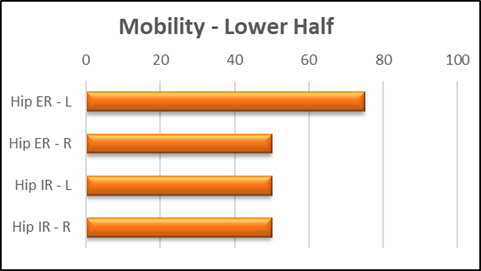
Video Analysis
In a sequential movement such as hitting, events early in the movement can create issues later in the swing. In Andrew’s case, an Excessive Negative Weight Shift and a lesser than desired Rear Hip Load were primary contributors to events downstream. The following is a brief summary of his hitting disconnects.
Linear Phase:
-
- Poor Rear Hip Load – Regardless of type of stance, the swing begins and fires in a spring around the rear hip socket. Knees should be inside the ankles from stance and continue throughout the stride in order to carry tension in the lower body throughout the stride to eventually be released into the upper body. Andrew’s lack of efficient hip IR was making it difficult to effectively create that coil and also create excessive negative weight shift.
- Excessive Negative Weight Shift – This is an excessive lower body lateral movement “away” from the pitcher during the negative move that forces the weight to the outside of the back foot. This can be caused by a number of things, namely poor ankle mobility / stability and / or issue with hip IR. Excessive weight shift during the negative move is a key contributor to timing issues of the lower body.
Rotational Phase:
-
- Elbows at Heel Strike – The bat must be slotted with the Back Elbow positioned below the Front Elbow from heel strike to contact. This helps to create a top hand up, bottom hand down position through contact.
Blast Motion Metrics
Although Andrew’s initial bat speed at 70 mph was within range, there were a few other areas that Blast results highlighted which could help him improve his performance at the plate.
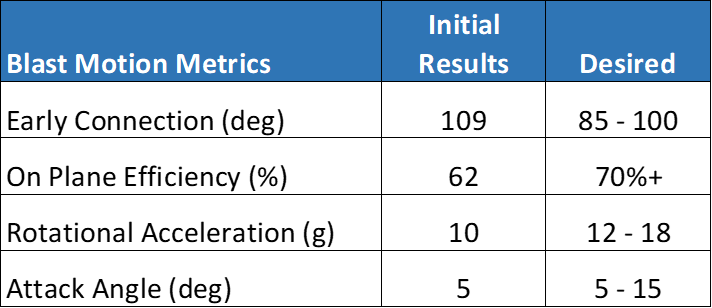
-
- Early Connection Angle / On Plane Efficiency – His elevated Early Connection Angle at 109 degrees was affecting his ability to stay on plane (62%) as well as he could.
- Rotational Acceleration – Andrew’s Rotational Acceleration at 10g’s was well below his target range for an athlete of his size. This was not only robbing him of additional potential bat speed but also power and adjustability at the plate.
- Attack Angle – Lastly, his Attack Angle at 5 degrees, although a result of earlier movements in his swing, was the likely contributor to a lower than desired slugging average.
K-vest (Posture) Assessment
K-vest is a motion capture technology which allows you to measure your posture and movement patterns of the upper body throughout the swing from first move to heel strike through to contact. Andrew’s initial results demonstrate relatively good overall postural patterns with a solid 1-2-3-4 kinematic sequence which allows to efficiently build angular velocity up the chain.
Below is a summary of his initial and most recent angular velocities up the chain. His numbers were excellent to begin with and even better now.
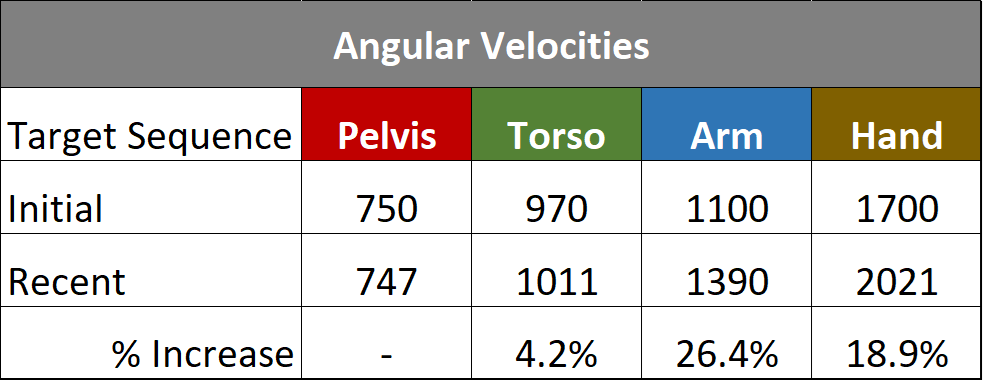
Initial Kinematic Sequence
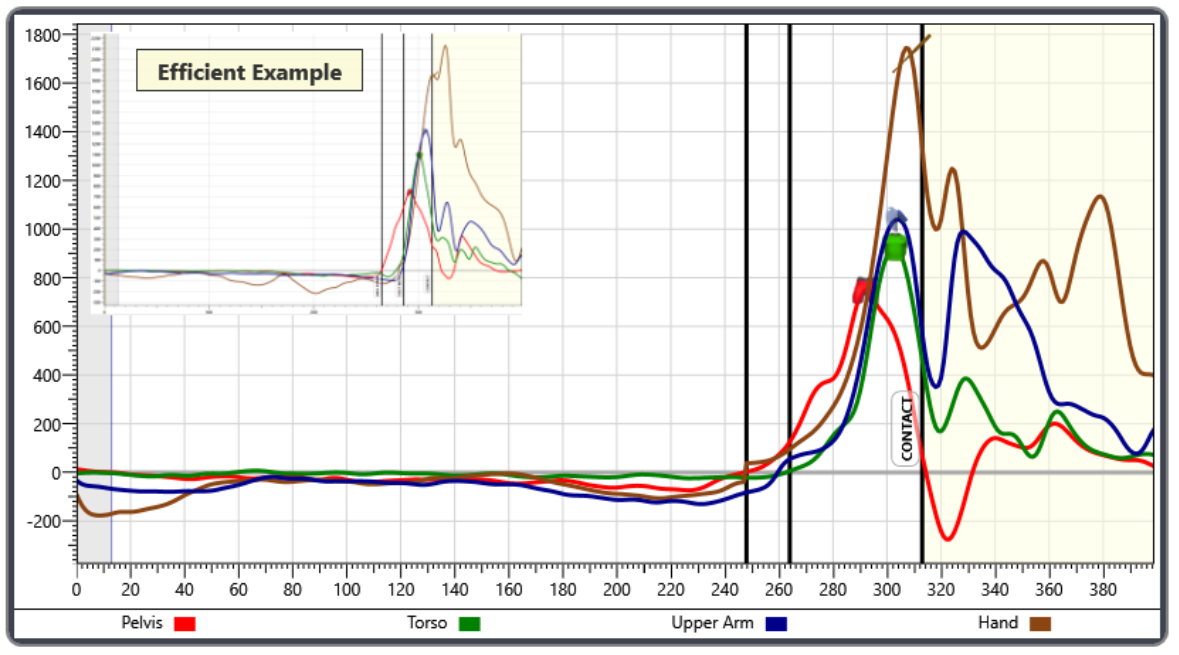
Recent Kinematic Sequence
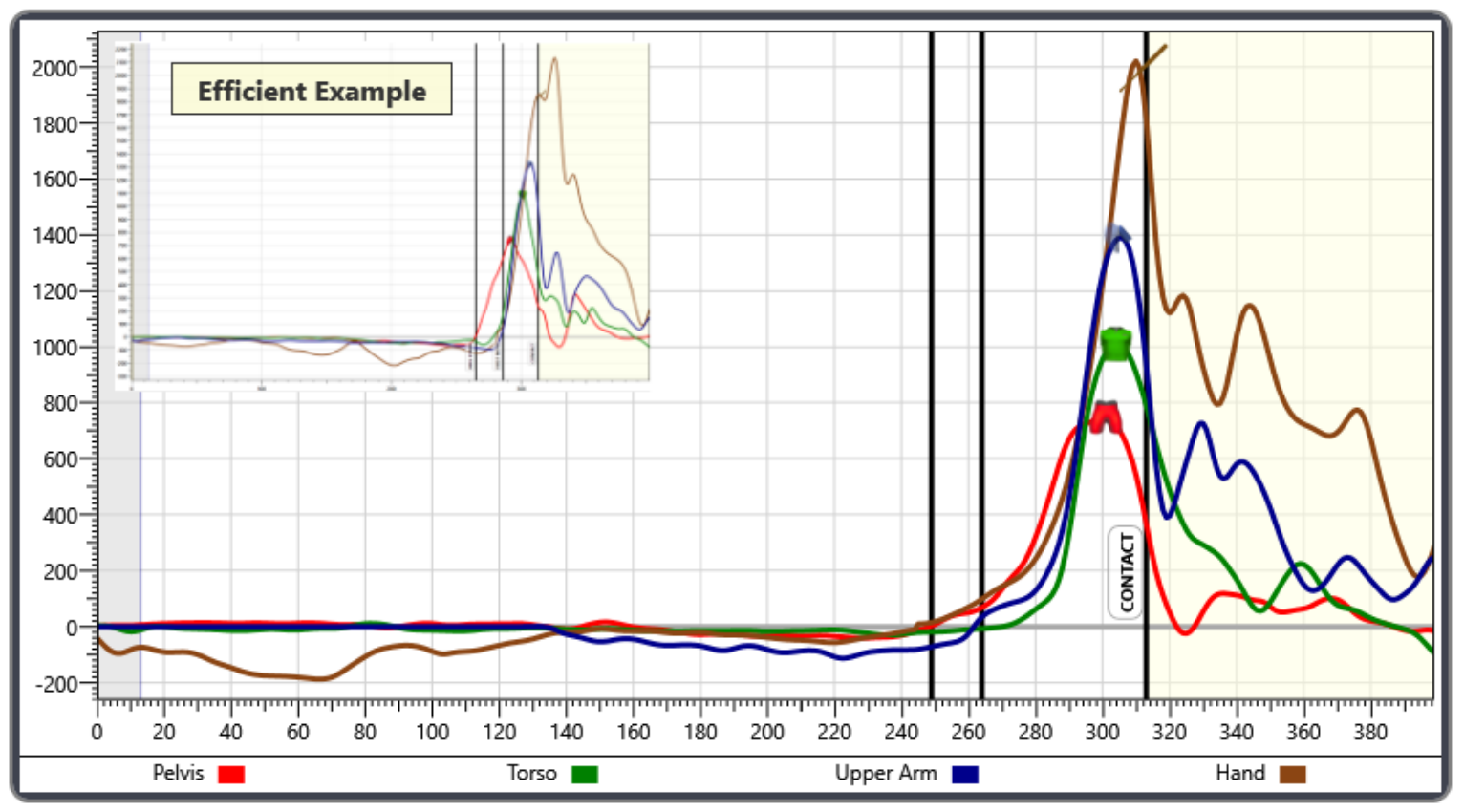
As with all things hitting, disconnects can all be interrelated. Fixing one will create positive change further downstream. His postural reports highlighted a couple of postural topics that should be addressed.
-
- Pelvis Bend @ First Move (results: 1 degree vs. desired range of 20-35 degrees) – Often times low numbers can mean the athlete is losing their hip hinge early and can be directly correlated to a poor hinge or excess neg weight shift. This can result in a loss of posture and less than optimal use of ground reaction forces. It can also cause the bat to be cut out of the zone early, as well as a key to keeping a good arc in the swing path.
- Torso Side Bend @ First Move (results: -13 degrees vs. desired range of -5-10 degrees) – This establishes correct posture in the swing. This also allows for a clean swing arc through the zone.
- Pelvis Rotation @ Contact (results: 101 degrees vs. desired range of 60-90 degrees) – Higher number (>90 degrees) is an indication of the hips landing too open which compromises efficient blocking and can cause poor deceleration rates. This also can reduce kinetic energy transfer up the chain and into the bat / ball.
Recent Assessment
The plan has been to get Andrew to improve his hip internal rotation while working on his loading phase and rotating more efficiently downstream so that he can improve his swing metrics. In addition, to other work in the weight room, Andrew was prescribed a variety of drills which have helped him address his disconnects, including Med Ball Decels, Feet Together Step & Hit, Slots Starts, and the Coil Drill.
During a recent re-assessment, it’s obvious that Andrew has made significant strides in a number of areas, including improving his mobility and loading the back leg more efficiently. In addition, his K-vest results and Blast metrics have all improved. The net result of all this is generally better contact with the ball which has resulted in a significant increase in his Exit Velo, which was recorded as high as 109 mph, recently.
The initial Blast metrics that needed to be improved have all shown great results. More specifically, his Rotational Acceleration is up from 10g to 16g which is quite significant. Hand-in-hand with that, his bat speed and power metrics have also improved. But more importantly, his Attack Angle is now on the upper half of the range at 13 degrees, which will help him drive the ball farther and deeper.
On top all of this, Andrew has also added 10 lbs. of lean muscle mass during this time period.
Great job Andrew, Keep up the hard work.
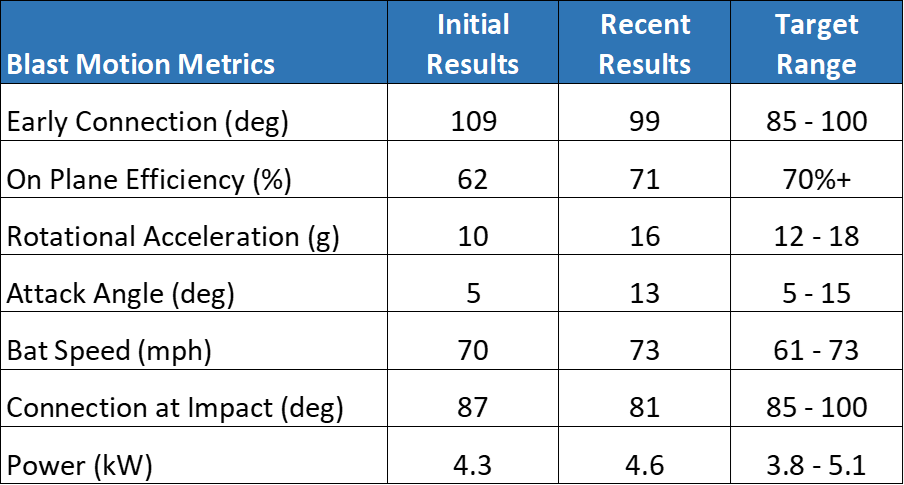
By Nunzio Signore, Andrew Pezzutto and Bahram Shirazi
You live too far to train with us in-house at RPP? You can now train with us on a REMOTE basis.


